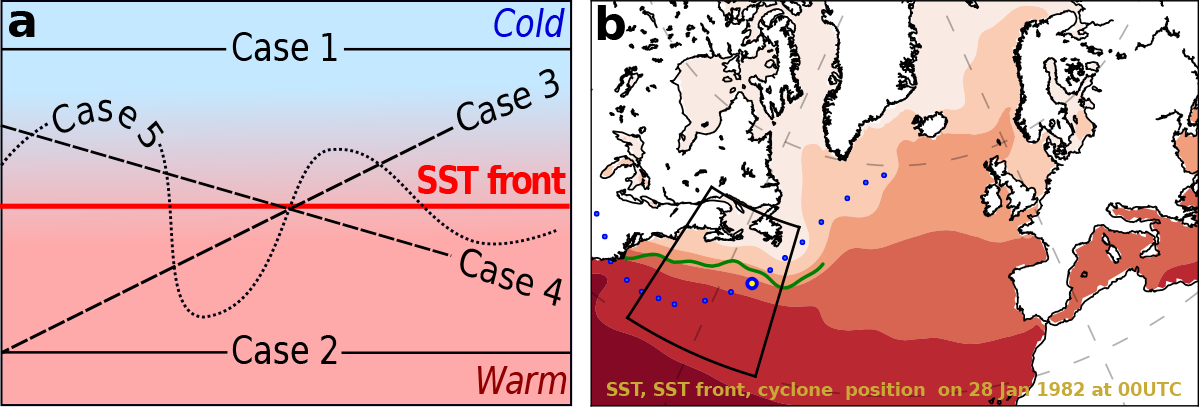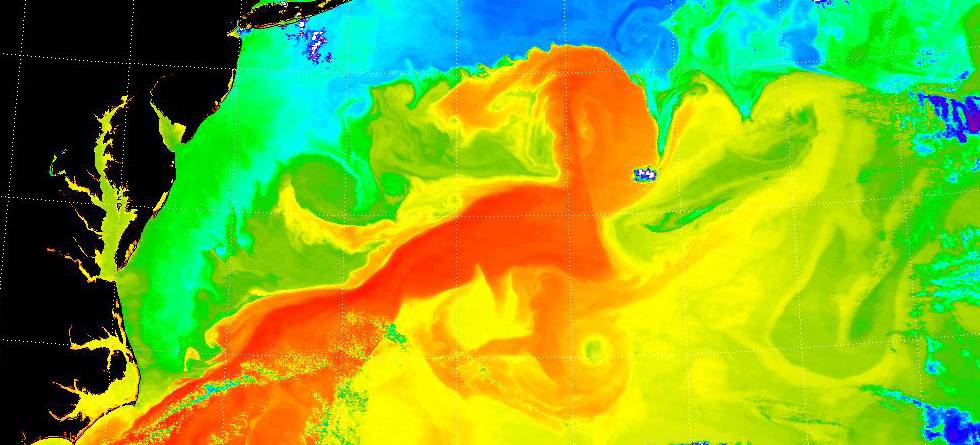Written by Leonidas Tsopouridis, researcher at the Bjerknes Centre for Climate Reserach and the Geophysical Institute at the University of Bergen.
We compare the characteristics of cyclones following different tracks relative to the SST front in the Gulf Stream and the Kuroshio region. We highlight the importance of the land-sea contrast on increasing low-level baroclinicity and thus cyclone intensification in the Gulf Stream region, while we underline the role of the Pacific upper-level jet on intensifying cyclones and increasing large-scale precipitation in the Kuroshio region.
The Northwest Atlantic and the Northwest Pacific feature strong SST gradients providing favourable conditions for wintertime cyclone intensification in the midlatitudes. To investigate the cyclone characteristics and the mechanisms leading to cyclone intensification in the two regions we track individual cyclones and categorize them depending on their propagation relative to the SST fronts, which were identified using an objective frontal detection scheme.
For the cyclone propagation, we considered five categories, yet concentrated on cyclones staying either on the cold (C1) or warm (C2) side of the SST front, and those crossing the SST front from the warm to the cold side (C3).

To compare the characteristics of cyclones following different tracks relative to the SST front, we performed a cyclone-relative composite analysis around the time of maximum intensification.
In our study for the Gulf Stream region, we identified that the land-sea contrast clearly influences cyclone intensification, particularly for cyclones propagating to the north of the SST front (C1), while the increased low-level baroclinicity observed for C3 cyclones is partially attributable to the Gulf Stream SST front. Both C1 and C3 cyclones are also associated with strong upper-level forcing.
We found convective precipitation to be closely related to the SSTs under the cyclones, while we hypothesized that low-level baroclinicity, via increased isentropic upglide, might be an additional factor determining precipitation intensity, in addition to moisture availability and cyclone intensity. However, given the special geographic characteristics of the western North Atlantic a generalisation of our results for other western boundary currents would not be straightforward.
Therefore, in our second study we focused on the Kuroshio region, which is located further away from the continent. Not surprisingly, we found land-sea contrast to play a less prominent role for the low-level baroclinicity in the Kuroshio compared to the Gulf Stream region. Contrary to our results for the Northwest Atlantic, we found cyclones remaining always on the warm side of the Kuroshio SST front to deepen more rapidly.
The propagation of cyclones over higher SSTs has been proved to enhance cyclone intensification, but the SSTs on the warm side of the Kuroshio SST front are lower compared to the respective in the Gulf Stream region, where C2 cyclones intensified the least. Moreover, low-level baroclinicity is weaker around the Kuroshio than around the Gulf Stream.
Therefore, we considered the upper-level forcing. We found the higher intensification of both C2 and C3 cyclones in the Kuroshio region to be consistent with their location close to the left exit of an intense upper-tropospheric jet stream, which also contributed to the higher observed large-scale precipitation.
Overall, our feature-based analyses highlighted the characteristics (e.g., moisture, surface heat fluxes, precipitation, wind speed) of cyclones following different pathways in the Gulf Stream and Kuroshio regions and identified the different mechanisms leading to cyclone intensification in the two regions.
Despite the fact that higher baroclinicity observed for cyclones in C3, was partially attributable to the SST fronts, which provide a conducive environment for cyclone growth, our results do not suggest a direct impact of the SST front on the intensification of individual cyclones propagating over the two ocean basins.
References
Tsopouridis L, Spensberger C, Spengler T., (2020) Characteristics of cyclones following different pathways in the Gulf Stream region, Quarterly Journal of the Royal Meteorological Society, 1-16, https://doi.org/10.1002/qj.3924
Tsopouridis L, Spensberger C, Spengler T., (2020) Cyclone Intensification in the Kuroshio Region and its relation to the Sea Surface Temperature Front and Upper-Level Forcing, Quarterly Journal of the Royal Meteorological Society, 1-16, https://doi.org/10.1002/qj.3929

